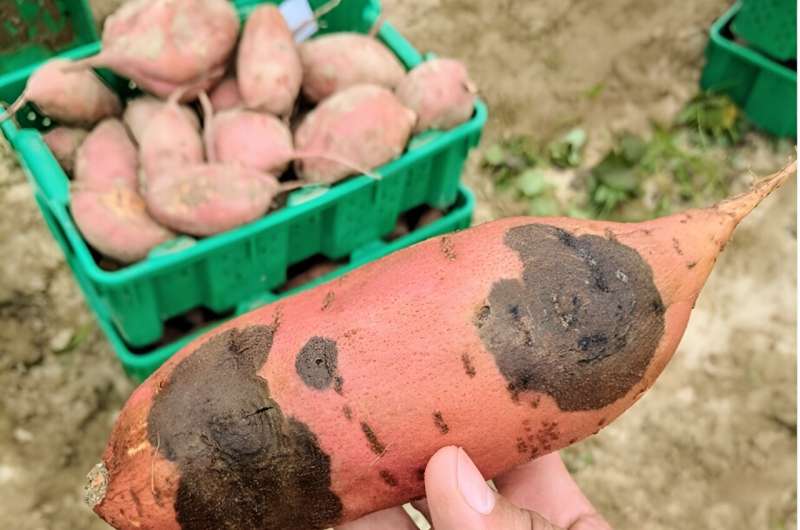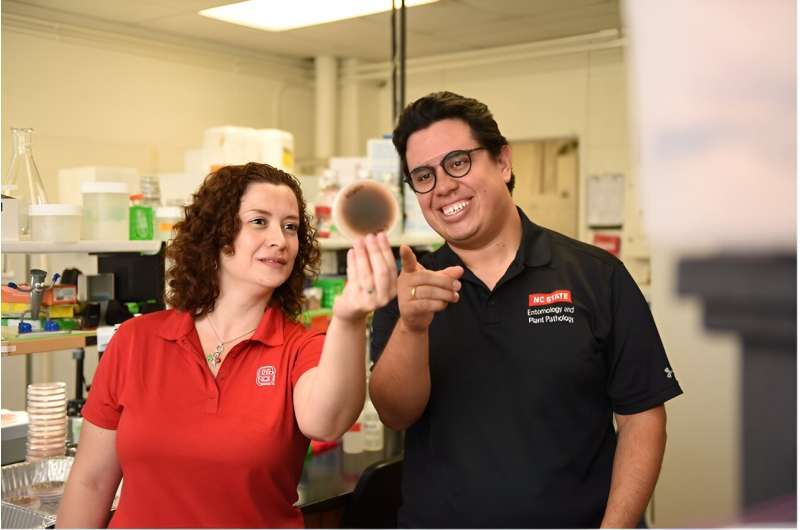This article has been reviewed according to Science X's editorial process and policies. Editors have highlighted the following attributes while ensuring the content's credibility:
fact-checked
peer-reviewed publication
proofread
Sweetpotato's sweet revenge against fungal disease

Sweetpotato black rot is a devastating disease caused by the fungus Ceratocystis fimbriata. Since the late 1800s, black rot of sweetpotato has threatened to destroy as much as 30% of the sweetpotato crop in the United States. In 2015, all sweetpotato-producing states in the United States experienced one of the worst outbreaks recorded in history, with up to 60% losses reported.
While fungicides can help manage the disease, they are not a sustainable solution, especially with volatile restrictions on fungicide residues among major export markets. An additional management strategy is effector-assisted breeding—a novel approach to developing disease-resistant crops.
Effectors are secreted proteins from pathogens that modulate their plant hosts at the molecular and cellular levels. Instead of traditional breeding methods, which can take many years and involve extensive trial and error, effector-assisted breeding uses specific effectors from the pathogen to quickly identify and select plants that have resistance to the disease. This will accelerate breeding programs, leading to the development of black rot–resistant sweetpotato varieties and the reduction of crop losses.

Until now, researchers had limited knowledge of C. fimbriata biology, thus creating a barrier in managing this disease. To address this, researcher Camilo Parada-Rojas from Lina Quesada-Ocampo's lab at North Carolina State University and colleagues focused on identifying the effector proteins produced by C. fimbriata during infection.
The study, published in Molecular Plant-Microbe Interactions (MPMI), identified 31 C. fimbriata effector genes. By cataloging these effectors, researchers can better understand how the fungus infects sweetpotato and identify potential host targets for breeding resistant varieties. Additionally, the study suggests a biotrophic phase, in which the fungus lives off living sweetpotato storage roots before killing it, providing a new perspective on how the disease progresses.
This research provides pioneering knowledge on C. fimbriata's biology and highlights potential targets for effector-assisted breeding. While the findings are promising, practical applications in disease control and plant breeding will require more time and research.
Parada-Rojas states, "It's a long journey from basic research to real-world application, but the potential to make a significant impact on crop resilience and food security makes it incredibly rewarding."
In the meantime, the study's insights into pathogen evolution and stability can inform disease monitoring, helping to track and manage the spread of C. fimbriata more effectively—taking science one step closer to futureproofing sweetpotato.
More information: Camilo H. Parada-Rojas et al, Effector Repertoire of the Sweetpotato Black Rot Fungal Pathogen Ceratocystis fimbriata, Molecular Plant-Microbe Interactions (2024). DOI: 10.1094/MPMI-09-23-0146-FI
Journal information: Molecular Plant-Microbe Interactions
Provided by American Phytopathological Society




















